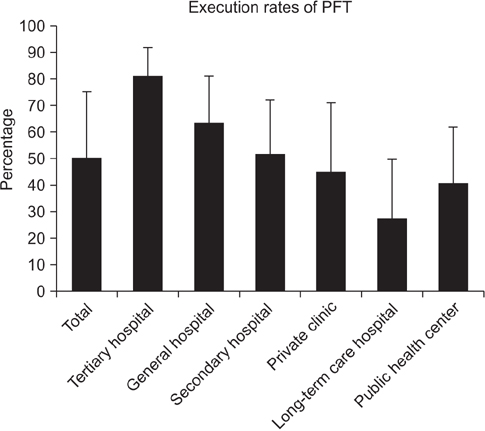Tuberc Respir Dis.
2017 Jul;80(3):241-246. 10.4046/trd.2017.80.3.241.
Evaluation of Appropriate Management of Chronic Obstructive Pulmonary Disease in Korea: Based on Health Insurance Review and Assessment Service (HIRA) Claims
- Affiliations
-
- 1Division of Respiratory and Critical Care Medicine, Department of Internal Medicine, Korea University Guro Hospital, Seoul, Korea. syl0801@korea.ac.kr
- KMID: 2385038
- DOI: http://doi.org/10.4046/trd.2017.80.3.241
Abstract
- Chronic obstructive pulmonary disease (COPD) is an ambulatory care-sensitive condition, and effective treatment of outpatients can prevent worsening of the illness and hospitalization. Current COPD guidelines provide appropriate guidance for the diagnosis and treatment of patients with COPD. In fact, it has been shown that when appropriate guidance and treatment are performed, the morbidity and mortality rates of COPD patients are reduced. However, there is a gap between the clinical guidelines and the actual clinical treatment. Therefore, the Health Insurance Review and Assessment Service (HIRA) conducted an evaluation of the adequacy of COPD diagnosis and treatment using the Claims Database of HIRA. This review provides a summary of the COPD adequacy assessment results reported by the HIRA and some brief comments on the results.
MeSH Terms
Figure
Cited by 1 articles
-
Direct and Indirect Costs of Chronic Obstructive Pulmonary Disease in Korea
Changhwan Kim, Younhee Kim, Dong-Wook Yang, Chin Kook Rhee, Sung Kyoung Kim, Yong-Il Hwang, Yong Bum Park, Young Mok Lee, Seonglim Jin, Jinkyeong Park, Cho-Rom Hahm, Chang-Han Park, So Yeon Park, Cheol Kweon Jung, Yu-Il Kim, Sang Haak Lee, Hyoung Kyu Yoon, Jin Hwa Lee, Seong Yong Lim, Kwang Ha Yoo
Tuberc Respir Dis. 2019;82(1):27-34. doi: 10.4046/trd.2018.0035.
Reference
-
1. Yoo KH, Kim YS, Sheen SS, Park JH, Hwang YI, Kim SH, et al. Prevalence of chronic obstructive pulmonary disease in Korea: the fourth Korean National Health and Nutrition Examination Survey, 2008. Respirology. 2011; 16:659–665.2. Lee J, Lee JH, Kim JA, Rhee CK. Trend of cost and utilization of COPD medication in Korea. Int J Chron Obstruct Pulmon Dis. 2017; 12:27–33.3. Mathers CD, Loncar D. Projections of global mortality and burden of disease from 2002 to 2030. PLoS Med. 2006; 3:e442.4. Lee JY, Rhee CK, Jung KS, Yoo KH. Strategies for management of the early chronic obstructive lung disease. Tuberc Respir Dis. 2016; 79:121–126.5. Organisation for Economic Co-operation and Development. Health at a glance 2015: OECD indicators. Paris: OECD;2015.6. Vogelmeier CF, Criner GJ, Martinez FJ, Anzueto A, Barnes PJ, Bourbeau J, et al. Global strategy for the diagnosis, management, and prevention of chronic obstructive lung disease 2017 report: GOLD executive summary. Eur Respir J. 2017; 49:1700214.7. Health Insurance Review & Assessment Service. Evaluation of appropriate management of COPD in Korea 2017 [Internet]. Wonju: Health Insurance Review & Assessment Service;2017. cited 2017 May 1. Available from: http://www.hira.or.kr/re/diag/getDiagEvlList.do?pgmid=HIRAA030004000000&WT.ac=%EB%B3%91%EC%9B%90%ED%8F%89%EA%B0%80.8. Beeh KM. The role of bronchodilators in preventing exacerbations of chronic obstructive pulmonary disease. Tuberc Respir Dis. 2016; 79:241–247.
- Full Text Links
- Actions
-
Cited
- CITED
-
- Close
- Share
- Similar articles
-
- A guide for the utilization of Health Insurance Review and Assessment Service National Patient Samples
- Towards Actualizing the Value Potential of Korea Health Insurance Review and Assessment (HIRA) Data as a Resource for Health Research: Strengths, Limitations, Applications, and Strategies for Optimal Use of HIRA Data
- Dilemmas Within the Korean Health Insurance System
- Health Insurance Claim Review Using Information Technologies
- Problems and future directions for quality evaluation of the Health Insurance Review and Assessment Service


